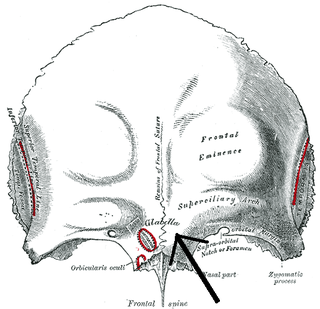
Trilobites are a group of extinct marine arachnomorph arthropods that form the class Trilobita. Trilobites form one of the earliest-known groups of arthropods. The first appearance of trilobites in the fossil record defines the base of the Atdabanian stage of the Early Cambrian period, and they flourished throughout the lower Paleozoic era before beginning a drawn-out decline to extinction when, during the Devonian, all trilobite orders except the Proetids died out. Trilobites disappeared in the mass extinction at the end of the Permian about 252 million years ago. The trilobites were among the most successful of all early animals, existing in oceans for over 300 million years.
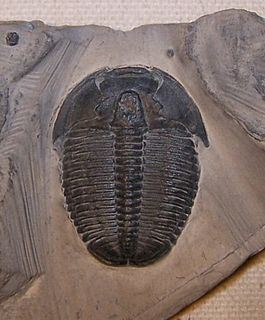
Ptychopariida is a large, heterogeneous order of trilobite containing some of the most primitive species known. The earliest species occurred in the second half of the Lower Cambrian, and the last species did not survive the Ordovician–Silurian extinction event.
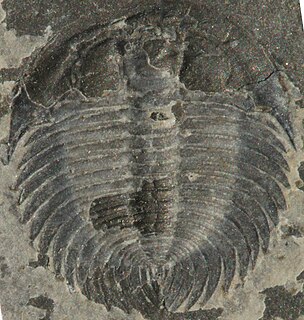
Corynexochida is an order of trilobite that lived from the Lower Cambrian to the Late Devonian. Like many of the other trilobite orders, Corynexochida contains many species with widespread characteristics.

Dalmanites is a genus of trilobite in the order Phacopida. They lived from the Late Ordovician to Middle Devonian.

Redlichiina is a suborder of the order Redlichiida of Trilobites. The suborder contains three superfamilies: Emuelloidea, Redlichioidea and Paradoxidoidea. These trilobites are some of the oldest trilobites known. They originated at the beginning of the Cambrian Period and disappeared at the end of the middle Cambrian.

Deiphon is a distinctive genus of Silurian phacopid trilobites of the family Cheiruridae found in Western and Central Europe, and in Central and Eastern United States. The type species, D. forbesi, from England, Bohemia, and Sweden, was discovered and described by the French paleontologist, Joachim Barrande in 1850.

Triarthrus is a genus of Upper Ordovician ptychopariid trilobite found in New York, Ohio, Kentucky, and Indiana, eastern and northern Canada, China and Scandinavia. It is the last of the Olenid trilobites, a group which flourished in the Cambrian period. The specimens of T. eatoni that are found in the Beecher's Trilobite Bed, Rome, New York area are exquisitely preserved showing soft body parts in iron pyrite. Pyrite preservation has given scientists a rare opportunity to examine the gills, walking legs, antennae and digestive systems of trilobites, which are rarely preserved. Triarthrus is therefore commonly used in science texts to illustrate trilobite anatomy and physiology.

Olenoides was a trilobite from the Cambrian period. Its fossils are found well-preserved in the Burgess Shale in Canada. It grew up to 10 cm long.
Calyptaulax is a genus of trilobites in the order Phacopida that existed during the middle and upper Ordovician in what is now the U.S. states of New York, Oklahoma, Illinois, Missouri, Virginia, Vermont, Nevada, Iowa, Wisconsin, Kentucky, and Iowa, as well as the Canadian provinces of Ontario, Newfoundland and Labrador, Quebec, and the territory of Nunavut. Other countries Calyptaulax fossils are known from include Ireland, Norway, Russia, and the United Kingdom. It was described by Cooper in 1930, and the type species is Calyptaulax glabella.

Ellipsocephalus is an extinct genus of blind trilobite that lived during the Cambrian. The genus comprises benthic species inhabiting deep, poorly lit or aphotic habitats. E. hoffi is a common trilobite mainly from central Europe.

Fallotaspis is a genus of redlichiid trilobite genus found in Early Cambrian-aged strata of the United States and Morocco.
The cephalon is the head section of an arthropod. It is a tagma, i.e., a specialized grouping of arthropod segments. The word cephalon derives from the Greek κεφαλή (kephalē), meaning "head".

The hypostome is the hard mouthpart of trilobites found on the ventral side of the cephalon (head). The hypostome can be classified into three types based on whether they are permanently attached to the rostrum or not and whether they are aligned to the anterior dorsal tip of the glabella.

The Olenelloidea are a superfamily of trilobites, a group of extinct marine arthropods. They lived during the late Lower Cambrian and species occurred on all paleocontinents.
Bolbolenellus is an extinct genus of trilobites, fossil marine arthropods, with five species attributed to it currently. It can be easily distinguished from all other trilobites by the combination of the absence of dorsal sutures in the head shield like all Olenellina, and a distinctly bulbous frontal lobe (L4) of the raised axial area in the head called glabella. The species lived at the end of the Lower Cambrian.
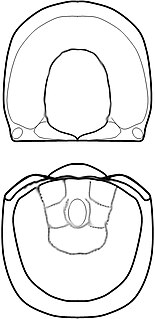
Galbagnostus is an extinct genus of agnostid trilobite. It lived during the Lower and Middle Ordovician.
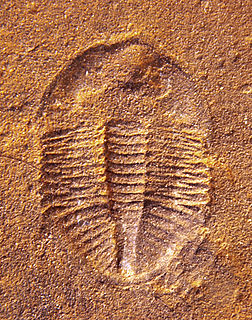
Ogygiocarella is a genus of asaphid trilobites. It occurred during the Middle Ordovician.

Cyclopyge is a genus of small to average size trilobites that lived during the Ordovician. Like all members of the family Cyclopigidae, it has very large convex eyes, that cover most of the free cheeks, and in some species touch each other. The eyes almost touch the large glabella. The occipital ring has merged with the rest of the glabella. The glabella does not extend into a frontal thorn. The cephalon lacks genal spines. The 6 thorax segments have short pleurae. The pygidium is rather large, and often rather effaced. These are features that also occur in other Cyclopygidae, and are indications of a pelagic lifestyle.

Cyclopygidae is a family of asaphid trilobites from the Ordovician. Cyclopygids had an extratropical distribution, and there is evidence that they lived in darker parts of the water column. Cyclopygids are characterized by enlarged eyes, with a wide angle of view, both horizontal and vertical, reminiscent of the eyes of dragonflies. These typically touch the glabella directly on the side. Cyclopygids all lack genal spines, but Symphysops carries a forward directed frontal spine on the glabella. It is presumed that at least the members of the genus Pricyclopyge swam upside down and had bioluminescent organs on the third thorax segment. Cyclopygids had between 7 and 5 thorax segments, a wide and stout axis, and short side lobes.

Raphiophoridae is a family of small to average-sized trilobites that first occurred at the start of the Ordovician and became extinct at the end of the Middle Silurian.
